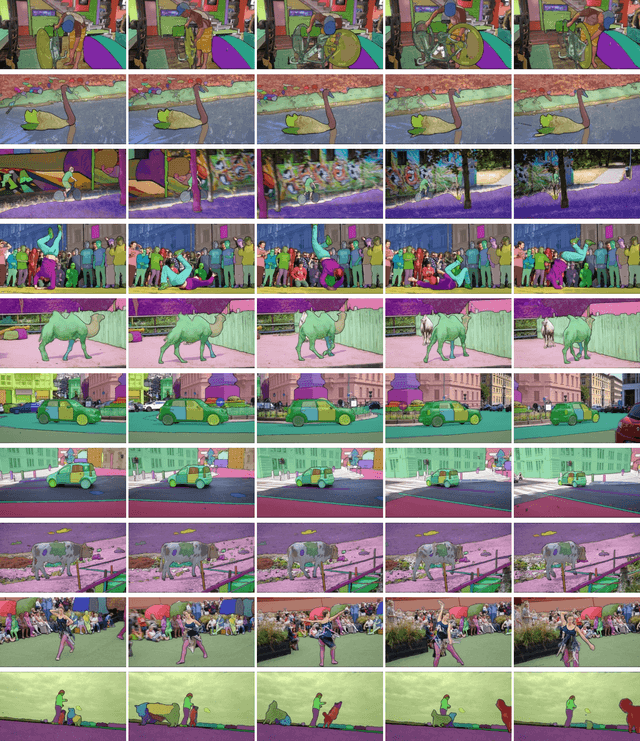Sangbeom Lim
URECA: Unique Region Caption Anything
Apr 07, 2025Abstract:Region-level captioning aims to generate natural language descriptions for specific image regions while highlighting their distinguishing features. However, existing methods struggle to produce unique captions across multi-granularity, limiting their real-world applicability. To address the need for detailed region-level understanding, we introduce URECA dataset, a large-scale dataset tailored for multi-granularity region captioning. Unlike prior datasets that focus primarily on salient objects, URECA dataset ensures a unique and consistent mapping between regions and captions by incorporating a diverse set of objects, parts, and background elements. Central to this is a stage-wise data curation pipeline, where each stage incrementally refines region selection and caption generation. By leveraging Multimodal Large Language Models (MLLMs) at each stage, our pipeline produces distinctive and contextually grounded captions with improved accuracy and semantic diversity. Building upon this dataset, we present URECA, a novel captioning model designed to effectively encode multi-granularity regions. URECA maintains essential spatial properties such as position and shape through simple yet impactful modifications to existing MLLMs, enabling fine-grained and semantically rich region descriptions. Our approach introduces dynamic mask modeling and a high-resolution mask encoder to enhance caption uniqueness. Experiments show that URECA achieves state-of-the-art performance on URECA dataset and generalizes well to existing region-level captioning benchmarks.
Multi-Granularity Video Object Segmentation
Dec 03, 2024



Abstract:Current benchmarks for video segmentation are limited to annotating only salient objects (i.e., foreground instances). Despite their impressive architectural designs, previous works trained on these benchmarks have struggled to adapt to real-world scenarios. Thus, developing a new video segmentation dataset aimed at tracking multi-granularity segmentation target in the video scene is necessary. In this work, we aim to generate multi-granularity video segmentation dataset that is annotated for both salient and non-salient masks. To achieve this, we propose a large-scale, densely annotated multi-granularity video object segmentation (MUG-VOS) dataset that includes various types and granularities of mask annotations. We automatically collected a training set that assists in tracking both salient and non-salient objects, and we also curated a human-annotated test set for reliable evaluation. In addition, we present memory-based mask propagation model (MMPM), trained and evaluated on MUG-VOS dataset, which leads to the best performance among the existing video object segmentation methods and Segment SAM-based video segmentation methods. Project page is available at https://cvlab-kaist.github.io/MUG-VOS.
Referring Video Object Segmentation via Language-aligned Track Selection
Dec 02, 2024Abstract:Referring Video Object Segmentation (RVOS) seeks to segment objects throughout a video based on natural language expressions. While existing methods have made strides in vision-language alignment, they often overlook the importance of robust video object tracking, where inconsistent mask tracks can disrupt vision-language alignment, leading to suboptimal performance. In this work, we present Selection by Object Language Alignment (SOLA), a novel framework that reformulates RVOS into two sub-problems, track generation and track selection. In track generation, we leverage a vision foundation model, Segment Anything Model 2 (SAM2), which generates consistent mask tracks across frames, producing reliable candidates for both foreground and background objects. For track selection, we propose a light yet effective selection module that aligns visual and textual features while modeling object appearance and motion within video sequences. This design enables precise motion modeling and alignment of the vision language. Our approach achieves state-of-the-art performance on the challenging MeViS dataset and demonstrates superior results in zero-shot settings on the Ref-Youtube-VOS and Ref-DAVIS datasets. Furthermore, SOLA exhibits strong generalization and robustness in corrupted settings, such as those with added Gaussian noise or motion blur. Our project page is available at https://cvlab-kaist.github.io/SOLA
 Add to Chrome
Add to Chrome Add to Firefox
Add to Firefox Add to Edge
Add to Edge